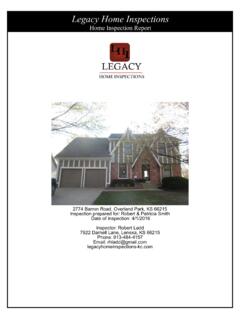Transcription of CRIME PREVENTION THROUGH ENVIRONMENTAL DESIGN …
1 CRIME PREVENTION THROUGH ENVIRONMENTAL DESIGN (CPTED) CPTEDWISCONSINCRIME PREVENTION THROUGH ENVIRONMENTAL DESIGNO shkosh Police Department CRIME PREVENTION Unit CRIME PREVENTION THROUGH ENVIRONMENTAL DESIGN Strategies April 2012 Page 2 FOR FURTHER INFORMATION OR ADDITIONAL COPIES OF THIS PUBLICATION, PLEASE CALL (920) 236 5742 OR EMAIL OR YOU CAN WRITE TO: OSHKOSH POLICE DEPARTMENT CRIME PREVENTION UNIT 420 JACKSON ST OSHKOSH, WI 54901 SPRING 2012 REVIEWED JANUARY 2017 EDITOR: JOSEPH NICHOLS CRIME PREVENTION THROUGH ENVIRONMENTAL DESIGN Strategies April 2012 Page 3 TABLE OF CONTENTS Acknowledgements 4 Introduction 5 History of CPTED 6 Principles of CPTED 7 3 D s Definition, Designation and DESIGN 10 CPTED DESIGN Strategies Single Family Residence 12 Multi Family Residence 15 Neighborhoods 18 Public/Municipal Building 22 Schools 24 Parks and Trails 27 Office Buildings 30 Commercial Property 33 Pharmacies 36 Hotels/Motels 39 Banks and ATM s 42 Manufacturing 45 Marina 48 Parking Garages 50 Lighting and Landscaping 53 Target Hardening 57 Doors 57 Windows 59 Locks 60 Fences 63 Alarms 64 Appearance 66 Summary 68 References.
2 Resources and Suggested Reading 69 CRIME PREVENTION THROUGH ENVIRONMENTAL DESIGN Strategies April 2012 Page 4 Acknowledgements Joseph W. Nichols, CPTED CRIME PREVENTION Officer Oshkosh Police Department 420 Jackson Street Oshkosh, WI 54901 (920) 236 5742 CRIME PREVENTION THROUGH ENVIRONMENTAL DESIGN Strategies April 2012 Page 5 INTRODUCTION Whether we are aware of it or not, we are constantly responding to our surroundings and our environment. How we respond to our surroundings can assist us to relate safely in our neighborhoods. An effectively designed environment supports and helps us feel safer and reduces the opportunities for criminal acts to occur. CRIME PREVENTION THROUGH ENVIRONMENTAL DESIGN or CPTED is based on the belief that the proper DESIGN and effective use of the built environment can lead to a reduction in the fear and incidence of CRIME and an improvement in the quality of life . CRIME PREVENTION is defined as, The anticipation, recognition and appraisal of a CRIME risk and the initiation of some action to remove or reduce it.
3 CPTED takes CRIME PREVENTION one step further by studying the site DESIGN and working with planners, engineers, landscape designers, landscape architects, arborists, and end user/owners and public development agencies in an attempt to create safer designs in new and existing developments. The following guidelines were prepared by the CRIME PREVENTION Office of the Oshkosh Police Department to be used as a tool for planners and DESIGN professionals to build quality development with the idea of reducing the opportunity for CRIME to occur. CPTED reviews are becoming standard practice in the planning process throughout the United States and the City of Oshkosh Police Department applies the principles of CPTED in their review of site plans. DESIGN professionals have always integrated into their work planned resistance to natural threats such as fire, earthquakes, floods and other bad weather. In recent years, DESIGN professionals have begun to recognize CRIME as a man made hazard that can be mitigated THROUGH quality DESIGN .
4 USING THIS DOCUMENT This document is designed to help DESIGN professionals, law enforcement personnel and anyone involved in or concerned with development of a single family or multi family residence, public buildings, office buildings and commercial uses. The concepts and strategies are discussed and illustrations are provided for various applications of CPTED measures in a variety of developments. The concepts and strategies of CPTED can be applied to both existing and new development. Ideally, CPTED concepts and strategies should be applied during the DESIGN phase to more fully benefit from the applications, as well as avoid costly changes later. DISCLAIMER: This document is a guide providing techniques and strategies. In a few areas this guide may conflict with the Wisconsin Statewide Building Code in some occupancy types, and the Wisconsin Statewide Building Code will always be the prevailing document. While our recommendations do not guarantee a CRIME free environment, it is our experience that the application of the concepts of CPTED will reduce the opportunity for CRIME to occur and will enhance the quality of life .
5 Local and state ordinances: Please refer to the proper county, city or town agencies before implementing any recommendations to assure conformance with county, city, town and state codes. CRIME PREVENTION THROUGH ENVIRONMENTAL DESIGN Strategies April 2012 Page 6 HISTORY OF CRIME PREVENTION THROUGH ENVIRONMENTAL DESIGN As early as 1961, Elizabeth Woods, who was at the time working at the Chicago Housing Authority, began noticing that public housing residents wanted and deserved a quality of life that was consistent with other areas of the City of Chicago. Woods began developing guidelines as to how a public housing area should be designed where residents had visibility to neighbor s and that there were gathering areas where residents could keep watch in the area. Jane Jacobs, in her book The Death and life of Great American Cities , discussed the interaction of the physical environment with its inhabitants and how important this is in the life and vitality of a street or neighborhood.
6 Jacobs listed the three attributes needed to make a city street safe: a clear demarcation of private and public space; diversity of use; and a high level of pedestrian use of the sidewalks. She also wrote the basis for community security is a strong sense of social cohesion and a feeling of control over one s home turf. In 1969, Defensible Space" was a phrase made up by Oscar Newman and later in 1972 a book authored by Newman. Newman placed emphasis on the specific DESIGN features of buildings and the neighborhood. Defensible space had two parts: First, defensible space should allow people to see and be seen continuously. Second, people must be willing to intercede or report a CRIME to police. In 1971, C. Ray Jeffrey wrote his book titled, CRIME PREVENTION THROUGH ENVIRONMENTAL DESIGN when he began investigating the physical environment and the incidence of CRIME . Jeffrey created the term CPTED and his works included interviewing inmates as to the correlation of crimes committed and the environment where the crimes occurred.
7 In 1982, James Wilson and George Kelling wrote Broken Windows . The concept of broken windows is one where in no matter what type of neighborhood, if a building is left with a broken window, graffiti, trash, etc., long enough, disorder and decline of the building or area surrounding it will spread. In 1985, the first CPTED training program began at the University of Louisville in Kentucky. An instructor at the school, Criminologist Timothy Crowe wrote CRIME PREVENTION THROUGH ENVIRONMENTAL DESIGN , Applications of Architectural DESIGN and Space Management Concepts which presented the building community and law enforcement a solid base on the concepts of CPTED. Between 1994 and 2002, Sparta Consulting Corporation managed the U. S. Government s largest CPTED training program. The Sparta led CPTED projects, that were focused on public and assisted housing, showed reductions in FBI Part 1 Crimes (aggravated assault, forcible rape, murder, robbery, arson, burglary, larceny theft and motor vehicle theft) ranging from 17% to 76% in specific high CRIME , low income areas.
8 Since 2004, the basics of CPTED have gained international renown and more and more communities throughout the world continue to embrace the concepts and ideas of CRIME PREVENTION THROUGH ENVIRONMENTAL DESIGN . CRIME PREVENTION THROUGH ENVIRONMENTAL DESIGN Strategies April 2012 Page 7 CRIME PREVENTION THROUGH ENVIRONMENTAL DESIGN (CPTED) CPTED is the proper DESIGN and effective use of the built environment and can lead to a reduction in the fear and incidence of CRIME and an improvement in the quality of life . Timothy Crowe (1950 2009), author of the book, CPTED, explains that The physical environment can be manipulated to produce behavioral effects that will reduce CRIME . These behavioral effects can be accomplished by reducing the propensity of the physical environment to support criminal behavior. There are four interconnected concepts of CPTED: Natural Surveillance, Natural Access Control, Territorial Reinforcement, and Maintenance. NATURAL SURVEILLANCE Natural Surveillance is the observation of areas by people.
9 A criminal is less likely to commit a CRIME if they can be seen by others. The proper placement of windows, landscaping, lighting and buildings, as well as areas that are used by people, are beneficial not only in preventing a CRIME from being committed, but also has a reverse effect on other people who feel secure knowing they can see and be seen by others. NATURAL SURVEILLANCE TO SEE AND BE SEEN. NATURAL SURVEILLANCE? WHAT IS HAPPENING INSIDE AND WHO IS ENTERING THE STORE? CRIME PREVENTION THROUGH ENVIRONMENTAL DESIGN Strategies April 2012 Page 8 NATURAL ACCESS CONTROL Natural Access Control is a means of controlling the access to a building by means of fencing, landscaping, sidewalks, lighting, walkways or signage. Natural Access ControI is not necessarily a means of keeping criminals out, but ensures that entrances are visible, well lit and overlooked by windows. Clearly defining entranceways and controlling other points of access to a building is important to Natural Access Control.
10 TERRITORIAL REINFORCEMENT Territorial Reinforcement is the use of physical barriers that show ownership of a property by the use of fences, landscaping, signage, pavement designs and lighting. Territorial Reinforcement should be designed to clearly show private spaces. MAINTENANCE Maintenance is very important to CPTED. The Broken Windows Theory is the basis for the Maintenance principal. Unkempt properties with broken windows, nuisances, graffiti, abandoned vehicles, etc. lead to further properties being unkempt and the image that the area is in decline and not being owned by the occupants. The criminal element sees the decline as a greater acceptance of disorder and begins to move in. Proper maintenance protects the quality of life in an area and promotes Ownership of a property. CRIME PREVENTION THROUGH ENVIRONMENTAL DESIGN Strategies April 2012 Page 9 ACTIVITY SUPPORT Another idea used to support CPTED is Activity Support. This idea places events or activities in public areas where the intended use is for residents, customers and other users which discourages criminal activity.





